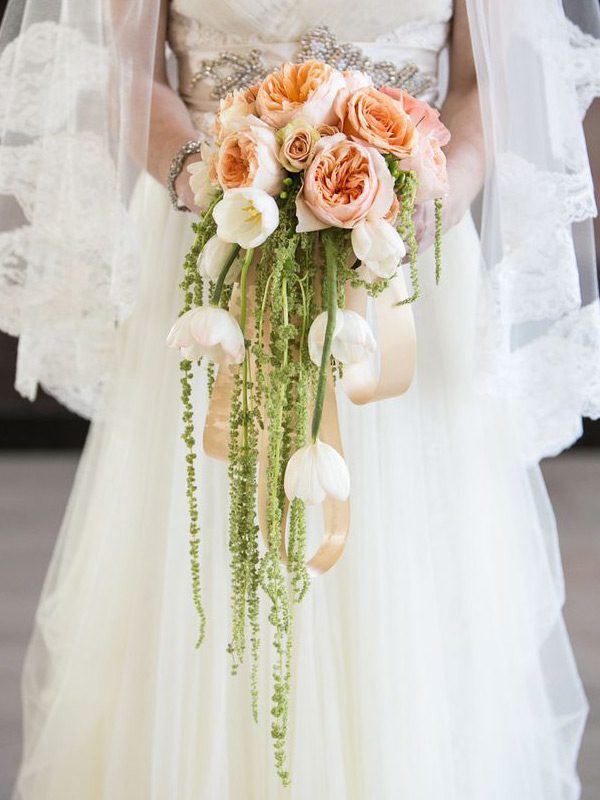Cascading – a gorgeous floral trend, for wedding flowers with impact.
One trend we’re loving right now is in florals. “Cascading” bouquets were originally called “shower bouquets,” as the flowers in the arrangement seemed to spill out from the top of the arrangement, trailing downwards as water would from a showerhead. This style was popular in the 1900’s, reaching a peek about the 1930s then trailing off in popularity after WWII. We didn’t see the cascading bouquet very much until Princess Diana’s wedding in 1981, at which point the style became popular for a moment.
Style icon Princess Diana made a statement not just with her dress, but also her bridal bouquet choice. A collection of traditional lily-of-the-valley, gardenias, stephanotis, freesia, yellow earl of Mountbatten roses, odontoglossum, orchids, ivy, tradescantia, veronica and the traditional sprig of myrtle adorned the princess’s impressive dress. At the time smaller, compact bouquets were in style, but her dress designers convinced Diana to opt for the cascade bouquet shape so the flowers wouldn’t be lost in the dress. Diana’s bouquet was 42″ long and 15″ wide made specifically in the fashion of the Victorian period. A mix-up with bouquets when Queen Elizabeth got married found her without a bouquet for family photographs; to ensure this didn’t happen again, three identical bouquets were made for Diana’s wedding. One was used for the rehearsal the night before, one for the ceremony, and the last was used in official family photographs. One of the bouquets was placed on the Tomb of the Unknown Soldier at Westminster, a tradition still carried on today. (Right) A nod to Diana’s bouquet can be made in a smaller, less opulent cascade style that would be most perfect for any Irish wedding.
HOW IT WORKS.
Whether the arrangement is big or small, long or short, filled with big bright flowers or a collection of smaller ones, the cascade bouquet trend is about feeling more than look. The bouquet needs to have movement about it; it is the total opposite of a strict, formal, perfectly dome shaped bouquet popular the past years. It’s about different heights and lengths of the florals, having an effect of spilling up and over; you want that same feeling about water moving like a waterfall or showerhead but this time working with the flowers.
There are plenty of arrangements to suit budgets and dress styles. Be it a smaller arrangement with two or three large blooms (think peonies or dahlias) with some trailing greenery, or a collection of smaller flowers interspersed with different sized blooms, to a mixture of flowers, twigs, leaves and foliage of various colors and textures, there really are no rules about this bouquet style other than it has to have that sense of movement about it.
The level of impact, just how big and trailing your bouquet will be, will depend on the flowers and color combinations you choose. For a flowing floral masterpiece opt for a combination of lush, large flowers, such as peonies and roses.Or for a more subtle approach stick to one variety of flower and compliment with soft jasmine and trailing ivy.
Whether dramatic or low key an important factor to note is that your cascading bouquet should not be part of your things to DIY list. Cascading bouquets can be quite intricate and heavy so they must be put together by a professional florist. Trust us, you don’t want to risk your beautiful cascading bouquet falling apart down the aisle!








